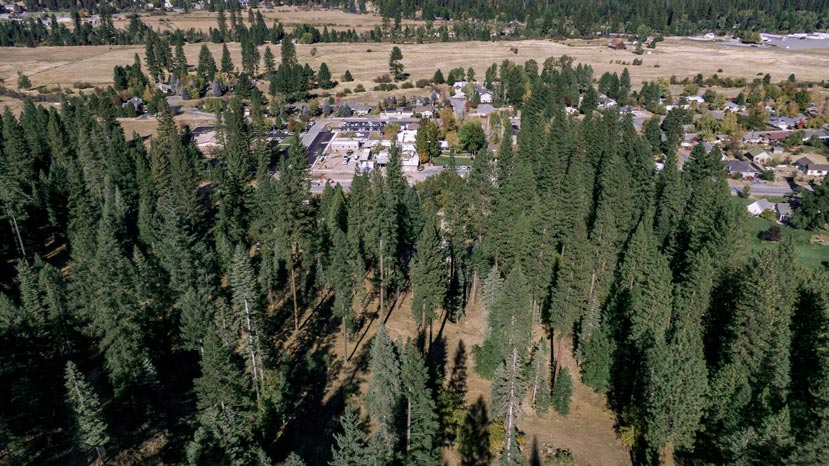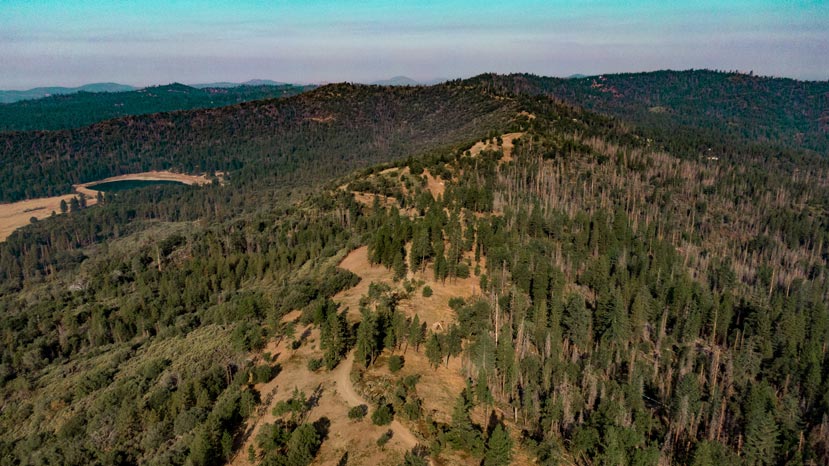
In early 2021, just two months after receiving funds as part of the state’s landmark budget commitment to wildfire resilience, the Sierra Nevada Conservancy (SNC) invested in 15 critical fuels-reduction projects aimed at reducing the threat of destructive wildfires. Less than 1.5 years later, two of those projects, the Quincy Wildfire Protection Project and the Wagner Ridge Fuel Break Project, are already finished, providing much-needed protection to forested landscapes, watersheds, communities, and even an essential small-town hospital.
While all of the 15 shovel-ready projects across the Sierra Nevada funded by the SNC are expected to wrap up by December 2024, the fuels-reduction work in Quincy and on Wagner Ridge between Mariposa and Tuolumne counties were completed this fall.
“It is imperative that we reduce the risk of wildfire to ensure the safety of our communities and the overall landscape throughout the Sierra Nevada-Cascade region,” said Angela Avery, executive officer with the SNC. “That was the goal of the state’s historic wildfire and forest resilience budget and our Immediate Action Wildfire and Forest Resilience grant program that followed. We couldn’t be more pleased to know that all 15 projects we funded are accomplishing these goals, and two of the projects are already done.”
Quincy project protects hospital, infrastructure, community
To help reduce overly dense fuels in what CAL FIRE determined a “very high fire hazard severity zone in a disadvantaged community,” one of the projects awarded by the SNC with early action funding was the Quincy Wildfire Protection Project.
Awarded July 2021, the project took just over one year to finish.
“The Quincy Wildfire Protection Project is right in town, we’re in the wildland-urban interface, and that made it very compelling for Sierra Nevada Conservancy and we hope that Quincy will be protected, or more resilient to fire,” said Kristy Hoffman, north-central area representative with the SNC.
Led by the Plumas County Fire Safe Council, the project reduced fuels on 151 acres of dense forest. The fact that it was also near an essential hospital made it that much more appealing.
“The significance here is that it is adjacent to critical infrastructure of the hospital and so this was a real strategic project area,” said Hannah Hepner, program manager for the Plumas County Fire Safe Council. “For us, for all our projects, is not stopping a wildfire from happening, necessarily, it’s creating a resilient landscape when fire does come because we know that it will.”
The overgrown condition of the forest and its location made this fuels-reduction work a feel-good story for others, as well.
“By next year we will be breaking ground on a $40 million, 36-bed skilled nursing facility, so this is absolutely something we jumped all over and I can’t thank the partners enough for listening and being willing to do this with us because this is something we couldn’t have done on our own,” said Darren Beatty, chief operating officer at Plumas District Hospital. “This was like a jungle thicket out here and we knew it was just a matter of time until something bad happened. So, it is great that it got completed before that did. This is one good news story we can all be proud of.”
Strategic fuel break protects towns, watersheds in Mariposa and Tuolumne counties
Just over one year after receiving funding from the SNC, the Mariposa County Fire Safe Council and partners completed the Wagner Ridge Fuel Break Project, which expanded and widened a critical shaded fuel break between two vital watersheds that will help with future firefighting efforts.
“It provides a strategic fuel break that protects forest health in both the Merced and Tuolumne River watersheds,” said Michael Pickard, SNC’s south-central area representative. “The Fire Safe Council has generated a 400-foot-wide shaded fuel break to provide firefighter access and a defendable anchor point for any suppression activities that might need to happen here.”
Although a shaded fuel break in and of itself may not stop a wildfire, it does create a place where firefighters can safely work and potentially halt a fire from jumping from one watershed into the other. Located strategically on a ridge between the Tuolumne River and the Merced River, and two watersheds with fairly steep slopes and dense forests, the 6.5-mile-long shaded fuel break will not only help protect nearby communities, but two vital water sources.

“The key thing about Wagner Ridge is that it’s the dividing line between two really critical watersheds and that is the watershed for the Merced River and the watershed for the Tuolumne River,” said Barbara Cone, executive director for the Mariposa County Fire Safe Council. “Both of those watersheds go into two significant lakes in the Central Valley and the water feeds the agriculture and the cities down below and so these watersheds are very critical to Central California.”
Historic state budget investments building resilience; more projects in the pipeline
The $20 million in early action funding that SNC received to improve forest health and build wildfire resilience in Sierra Nevada communities was quickly and effectively distributed to fuels-reduction projects across the region. Two of those projects have successfully been completed and another 13 projects, including building resilience in the footprint of the Dixie Fire in Plumas National Forest, are nearly complete.
While the rapid deployment of resources was exactly what the state intended in order to address the threat of destructive wildfires, more work is still needed across the Sierra Nevada-Cascade region, and demand for state funding remains strong. In the fiscal year of 2021–22, the SNC was awarded a total of $61 million in wildfire and climate budget packages. Grant requests from partners for this funding exceeded $150 million, however, illustrating just how much work is needed and how many capable organizations are ready and able to implement the work.
In March 2023, the SNC anticipates awarding another round of Watershed Improvement Program grants for wildfire and forest resilience projects, and may announce the first recipient of a Landscape Grant Program pilot award. The SNC is also helping to build project pipelines and partnerships through the Regional Forest and Fire Capacity Program.
This approach of supporting innovative new approaches and getting critical forest-health work implemented is how the SNC looks to create wildfire and forest resilience across the 27-million-acre Sierra Nevada-Cascade region.
